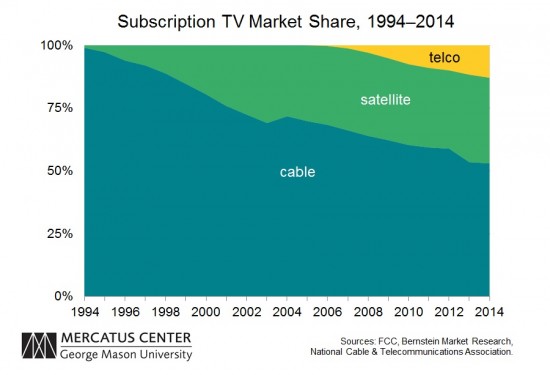Throughout the year, I collect some of the more notable tech policy-related essays that I’ve read and then publish an end-of-year list here. (Here, for example, are my end-of-year lists from 2014 and 2013.) So, here are some of my favorite essays and editorials from 2015. (Note: They are just in chronological order. No ranking here.)
- Larry Downes – “Take note Republicans and Democrats, this is what a pro-innovation platform looks like,” Washington Post, January 7. (Downes explains how governments need to adapt to accommodate and embrace new forms of technological innovation. He notes: “Here at home, the opportunity to wrap themselves in the flag of innovation is knocking for both parties, but so far there are few takers. Republicans and Democrats regularly invoke the rhetoric of innovation, entrepreneurship, and the transformative power of technology. But in reality neither party pursues policies that favor the disruptors. Instead, where lawmakers once took a largely hands-off approach to Silicon Valley, as the Internet revolution enters a new stage of industry transformation, the temptation to intervene, to usurp, to micromanage, to circumscribe the future — becomes irresistible.”) Equally excellent was Larry’s essay later in the year, “Fewer, Faster, Smarter.” (“As the technology revolution proceeds, the concept of government may return to its pre-industrial roots, setting the most basic rules of the economy and standing by as regulator of last resort when markets fail for some or all consumers over an extended period of time. Even then, the solution may simply be to tweak the incentives to encourage better behavior, rather than more full-fledged—and usually ill-fated—micromanagement of fast-changing industries.”)
- Bryant Walker Smith – “Slow Down That Runaway Ethical Trolley,” CIS Blog, January 12. (Smith, a leading expert on autonomous vehicle systems, notes that, while serious ethical dilemmas will always be present with such technologies, we should not allow the perfect to be the enemy of the good. “The fundamental ethical question, in my opinion, is this: In the United States alone, tens of thousands of people die in motor vehicle crashes every year, and many more are injured. Automated vehicles have great potential to one day reduce this toll, but the path to this point will involve mistakes and crashes and fatalities. Given this stark choice, what is the proper balance between caution and urgency in bringing these systems to the market? How safe is safe enough?”)
- Tim Worstall – “Google gets my data, I get search and email and that. Help help, I’m being OPPRESSED!” The Register, February 4. (A wicked tongue-lashing of the critics of the data-driven economy.)
- Aki Ito – “Six Things Technology Has Made Insanely Cheap: Behold the power of American progress,” Bloomberg Business, February 5. (The title says it all.)
- Andrew McAfee – “Who are the humanists, and why do they dislike technology so much?” Financial Times, July 7, 2015. (A brief but brilliant exploration of the philosophical fight over differing conceptions of “humanism.” McAfee, appropriately in my opinion, calls into question technological critics who self-label themselves “humanists” and then suggest that those who believe in the benefits of technological innovation and progress are somehow opposed to humanity. In reality, of course, nothing could be further from the truth!)
- Jocelyn Brewer – “Techno-Fear is Hurting Kids, Not Their Use of Digital Devices,” July 7, 2015. (A beautiful piece that makes it clear why “the Internet… is not addictive. Technology is not a drug.” Brewer continues on to make the case for avoiding fear-based messaging about Internet problems and instead adopting a more sensible approach: “Rather than trotting out interminable lists of the negative consequences of our adoption of technology lets raise awareness of how to avoid the pitfalls of not approaching this new era with solutions and proactive thinking.” Amen, sister!)
- Evan Ackerman – “We Should Not Ban ‘Killer Robots,’ and Here’s Why,” IEEE Spectrum, July 29, 2015, (A thought-provoking piece about a controversial subject in which Ackerman argues that “banning the technology is not going to solve the problem if the problem is the willingness of humans to use technology for evil”)
- Tim O’Reilly – “Networks and the Nature of the Firm,” Medium, August 14, 2015. (Explores the economics of the sharing economy and “the huge economic shift led by software and connectedness.”)
- Joe Queenan – “America’s Need for Pointless Updates and Cat Videos,” Wall Street Journal, December 3, 2015. (“The back-to-nature, turn-off-your-cellphone movement is based on a false assumption. . . . Time not spent doing dumb stuff would otherwise be wasted doing other dumb stuff. It’s called ‘play,’ without which Jack is a dull boy. It is a variation on the old saying that nature abhors a vacuum. So nature created the Internet.”)
- Dominic Basulto – “Can we just stop with all these tech dystopia stories?” Washington Post, Dec 8, 2015. (“Yes, a dystopian future is possible, but so is a utopian future. Most likely, the answer is somewhere in the middle, the way it’s been for millennia.”)



 The Technology Liberation Front is the tech policy blog dedicated to keeping politicians' hands off the 'net and everything else related to technology.
The Technology Liberation Front is the tech policy blog dedicated to keeping politicians' hands off the 'net and everything else related to technology.
Quick Thoughts on FAA’s Proposed Drone Registration System
by Adam Thierer on October 19, 2015 · 1 comment
Here are some quick initial reactions on the proposed registration rules: Continue reading →